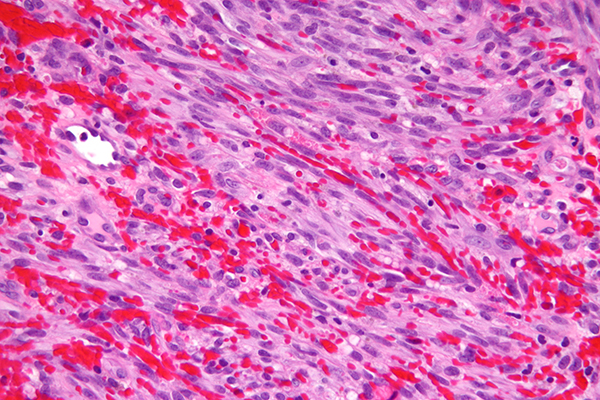Scientists from UCLA say they have described for the first time the structure of the herpesvirus associated with Kaposi's sarcoma. They believe their discovery answers critical questions about how the virus spreads and offers a potential roadmap for the development of antiviral drugs to combat both that virus and the more common Epstein-Barr virus, which is present in more than 90% of the adult population and is believed to have a nearly identical structure.
The lab study (“Structure and Mutagenesis Reveal Essential Capsid Protein Interactions for KSHV Replication”), published in Nature, shows that an inhibitor could be developed to break down the herpesvirus. Kaposi's sarcoma-associated herpesvirus (KSHV) is known to cause cancer in humans.
KSHV was discovered in the mid 1990s during the AIDS epidemic, when as many as half of people with AIDS were found to have the virus; it continues to be the most common cancer-causing virus associated with AIDS, according to the researchers.
No vaccine or drug has been developed to prevent or treat KSHV or the cancer it causes; nor has a vaccine or treatment been developed for Epstein-Barr, another member of the herpesvirus family and one of the most common viruses in humans. Epstein-Barr is best known for causing infectious mononucleosis, but it is also associated with an increased risk for several cancers, as well as a rare type of head-and-neck cancer called nasopharyngeal carcinoma.
Knowing the atomic structure of the herpesvirus's protein shell (capsid) could be an important step toward antiviral therapies. It would give scientists specific targets in the protein shell that are critical to the virus' ability to spread.
“Here we report a 4.2 Å resolution structure of the KSHV capsid, determined by electron-counting cryo-electron microscopy, and its atomic model, which contains 46 unique conformers of the major capsid protein (MCP), the smallest capsid protein (SCP) and the triplex proteins Tri1 and Tri2. Our structure and mutagenesis results reveal a groove in the upper domain of the MCP that contains hydrophobic residues that interact with the SCP, which in turn crosslinks with neighbouring MCPs in the same hexon to stabilize the capsid. Multiple levels of MCP–MCP interaction—including six sets of stacked hairpins lining the hexon channel, disulfide bonds across channel and buttress domains in neighbouring MCPs, and an interaction network forged by the N-lasso domain and secured by the dimerization domain—define a robust capsid that is resistant to the pressure exerted by the enclosed genome,” write the investigators.
“The triplexes, each composed of two Tri2 molecules and a Tri1 molecule, anchor to the capsid floor via a Tri1 N-anchor to plug holes in the MCP network and rivet the capsid floor. These essential roles of the MCP N-lasso and Tri1 N-anchor are verified by serial-truncation mutageneses. Our proof-of-concept demonstration of the use of polypeptides that mimic the smallest capsid protein to inhibit KSHV lytic replication highlights the potential for exploiting the interaction hotspots revealed in our atomic structure to develop antiviral agents.”
Without that atomic description, it was impossible to target specific sites of the enormous capsid to disrupt the spread of the virus,” said Z. Hong Zhou, Ph.D., a professor of microbiology, immunology, and molecular genetics, a member of UCLA's California NanoSystems Institute, and a senior author of the research. “Our study provides that [3D] atomic description.”
“The high pressure caused by the densely packed herpesvirus genome also means that if one unit is weakened, the whole structure will fall apart,” adds Ren Sun, Ph.D., a professor of molecular and medical pharmacology, and bioengineering, a member of the California NanoSystems Institute, and the study's co-senior author. “This offers a distinct advantage as a mechanism for drug development.”
Dr. Sun's group is following up on these findings by screening for drugs that could perform similar antiviral actions in humans.






